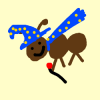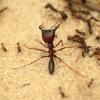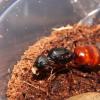Edited by cooIboyJ, July 26 2024 - 11:11 AM.
- Formiculture.com
- Forums
- Gallery
- Members
- Member Map
- Chat

Edited by cooIboyJ, July 26 2024 - 11:11 AM.
“You’ll survive” -wise man.
Currently keeping:
Brachymyrmex patagonicus
Solenopsis invicta
Crematogaster sp.
luck on the queens!
Currently keeping: 2 C.vicinus colonies.2 C.sansabeanus. 1 C.leavissimus. 2 C.Ca02. 1 V.pergandei. 4 T.immigrans.1 F.pacifica. 1 C.hyatti
1 M.ergatognya
Trying to get my hands on :C.modoc,A.vercicolor, and Any Honeypots
“You’ll survive” -wise man.
Currently keeping:
Brachymyrmex patagonicus
Solenopsis invicta
Crematogaster sp.
“You’ll survive” -wise man.
Currently keeping:
Brachymyrmex patagonicus
Solenopsis invicta
Crematogaster sp.
“You’ll survive” -wise man.
Currently keeping:
Brachymyrmex patagonicus
Solenopsis invicta
Crematogaster sp.
You should check on them less to avoid stress.
Currently keeping: 2 C.vicinus colonies.2 C.sansabeanus. 1 C.leavissimus. 2 C.Ca02. 1 V.pergandei. 4 T.immigrans.1 F.pacifica. 1 C.hyatti
1 M.ergatognya
Trying to get my hands on :C.modoc,A.vercicolor, and Any Honeypots
“You’ll survive” -wise man.
Currently keeping:
Brachymyrmex patagonicus
Solenopsis invicta
Crematogaster sp.
“You’ll survive” -wise man.
Currently keeping:
Brachymyrmex patagonicus
Solenopsis invicta
Crematogaster sp.
Edited by cooIboyJ, August 12 2024 - 1:19 PM.
“You’ll survive” -wise man.
Currently keeping:
Brachymyrmex patagonicus
Solenopsis invicta
Crematogaster sp.
I’ve checked on the solo queen and the pupae are getting a color similar to a light grey and I saw some pupae which didn’t have cocoons, any idea of why they don’t have cocoons?
formicines will sometimes remove the cocoon right before the pupae transform into callows, they need help escaping the cocoon because their mandibles are not sclerotized and too soft to bite anything.
.
Edited by mbullock42086, August 12 2024 - 1:21 PM.
does this mean that they will turn into workers soon?formicines will sometimes remove the cocoon right before the pupae transform into callows, they need help escaping the cocoon because their mandibles are not sclerotized and too soft to bite anything.I’ve checked on the solo queen and the pupae are getting a color similar to a light grey and I saw some pupae which didn’t have cocoons, any idea of why they don’t have cocoons?
.
“You’ll survive” -wise man.
Currently keeping:
Brachymyrmex patagonicus
Solenopsis invicta
Crematogaster sp.
does this mean that they will turn into workers soon?
formicines will sometimes remove the cocoon right before the pupae transform into callows, they need help escaping the cocoon because their mandibles are not sclerotized and too soft to bite anything.I’ve checked on the solo queen and the pupae are getting a color similar to a light grey and I saw some pupae which didn’t have cocoons, any idea of why they don’t have cocoons?
.
It is still the same thing as a cocoon only with no casing around it. It doesn't really affect the growth of the ant in any way besides making it more vulnerable.
Keeping:
3x - S. molesta (colonies and single queen) 1x - C. nearcticus (founding but no eggs) ![]() New!
New!
1x - C. chromaiodes (colony) 1x - C. subbarbatus (founding)
1x - F. subsericea (founding) 1x - T. sessile (mega colony)
3x - P. imparis (colonies)
2x - L. neoniger (founding)
Check out my C. nearcticus journal here: https://www.formicul...cticus-journal/
Check out my C. chromaiodes journal here: https://www.formicul...aiodes-journal/
does this mean that they will turn into workers soon?
formicines will sometimes remove the cocoon right before the pupae transform into callows, they need help escaping the cocoon because their mandibles are not sclerotized and too soft to bite anything.I’ve checked on the solo queen and the pupae are getting a color similar to a light grey and I saw some pupae which didn’t have cocoons, any idea of why they don’t have cocoons?
.
The darkening of color means they will eclose soon. As for the pupae without cocoons, 'naked' pupae as they're called, larvae need substrate to spin cocoons in the first place. A test tube often doesn't have the substrate necessary for the larvae to spin cocoons, and they just form naked pupae instead. It's harmless, nothing to be concerned about. As previously mentioned they are a little more tender and vulnerable than cocooned pupae, but other than that they're the same. The ones that did spin cocoons probably used the few cotton strands they had available.
"God made..... all the creatures that move along the ground according to their kinds (including ants). And God saw that it was good. Genesis 1:25 NIV version
Keeping:
Formica cf. pallidefulva, cf. incerta, cf. argentea
Formica cf. aserva, cf. subintegra
Myrmica sp.
Lasius neoniger, brevicornis
Edited by cooIboyJ, August 12 2024 - 6:35 PM.
“You’ll survive” -wise man.
Currently keeping:
Brachymyrmex patagonicus
Solenopsis invicta
Crematogaster sp.
They should eclose about 2-4 days after they start darkening, depending on species.
"God made..... all the creatures that move along the ground according to their kinds (including ants). And God saw that it was good. Genesis 1:25 NIV version
Keeping:
Formica cf. pallidefulva, cf. incerta, cf. argentea
Formica cf. aserva, cf. subintegra
Myrmica sp.
Lasius neoniger, brevicornis
“You’ll survive” -wise man.
Currently keeping:
Brachymyrmex patagonicus
Solenopsis invicta
Crematogaster sp.
Congrats! Make sure to feed them shortly after or at least in the next day (anywhere within the week is fine) If they don’t accept (which is natural) it’s because the queen is feeding them her “soup” from her broken down wing muscles like what she feeds to the nanitics as they were larvae. Feed them honey or sugar water. Honey can be diluted with a drop of water if you want to dilute it at all, (my B. depilis colony at about the same age was fed a very small drop of honey that wasn’t diluted and they where still able to drink it without drowning) all though it is still recommended to do so as these guys are a whole step smaller than S. molesta. Once again, congrats with the nanitics! Looking forward to seeing all these colonies grow!Nanitics!!!!!!!!!!! I didn’t get any pics but there are four tiny worker ants running around and helping feed brood. I gave them their first meal earlier today, it was just a tiny bit of honey but I put them back in their towel before I could watch them eat because I didn’t want to disturb them too much.
Keeping:
3x - S. molesta (colonies and single queen) 1x - C. nearcticus (founding but no eggs) ![]() New!
New!
1x - C. chromaiodes (colony) 1x - C. subbarbatus (founding)
1x - F. subsericea (founding) 1x - T. sessile (mega colony)
3x - P. imparis (colonies)
2x - L. neoniger (founding)
Check out my C. nearcticus journal here: https://www.formicul...cticus-journal/
Check out my C. chromaiodes journal here: https://www.formicul...aiodes-journal/
They ate all of the tiny drop of undiluted honey I gave them.
“You’ll survive” -wise man.
Currently keeping:
Brachymyrmex patagonicus
Solenopsis invicta
Crematogaster sp.
“You’ll survive” -wise man.
Currently keeping:
Brachymyrmex patagonicus
Solenopsis invicta
Crematogaster sp.
 |
Ant Keeping →
Ant Keeping Journals →
asd’s journal of Dark Rover Ants (B. patagonicus)Started by AsdinAnts , Apr 12 2024 |
|

|
|
Ant Keeping →
General Ant Keeping →
Any Brachymyrmex patagonicus tips and advice?Started by ArcaneAnt , Jan 31 2022 |
|

|
||
Ant Keeping →
Ant Keeping Journals →
ArcaneAnt's Black Rover Colony JournalStarted by ArcaneAnt , Jan 31 2022 |
|

|
||
Market Place →
General Market Place →
TEXAS ANTS-Thinning out my colonies +ATTAStarted by Jameso2001 , May 3 2021 |
|

|
||
Market Place →
General Market Place →
TEXAS ANTS-Thinning out my colonies +ATTAStarted by Jameso2001 , May 3 2021 |
|

|
0 members, 1 guests, 0 anonymous users